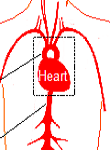|
|
|
Contribution of Cellular Mechanisms in the Development of Thoracic Aortic Aneurysms
|
|
|
|
|
|
|
|
|
|

|
|
|
|
Aruna poduri and Amit Khanna
|
|
|
|
apoduri@stanford.edu and 2Buck Institute of Aging
|
|
Departmentof Biology, Stanford University, Palo Alto, CA 94305-5020, BuckInstitute of Aging, Novato, CA, 8001 Redwood Blvd, Novato, CA 94945, USA
|
|
apoduri@stanford.edu
|
|
|
|
|
|
|
|
|
|

|
|
Thoracic aortic aneurysm (TAA) is a devastating vascular disease. TAA patients have dilated ascending aorta that eventually ruptures and leads to death. Treatment of TAA is limited to surgery only. The structural and morphological changes localized to the ascending region have intense effect on functioning of the aorta. Recent scientific studies have demonstrated that the underlying cause of TAA is a result of various alterations at the cellular level. Given that there is an absence of a direct pharmacological treatment forT AA, therefore a growing demand to determine the underlying mechanisms of TAA is utmost necessary to elucidate. Till date, a great progress has been made to diagnose and identify the risk factors of TAA, however a better understanding of the mechanisms that trigger the progression is needed in order to develop new therapeutic strategies. The current review compiles the recent highlights about the contributions of cellular mechanisms involved in the development of TAA.
|
|
|
|
|
|
|
|

|
|